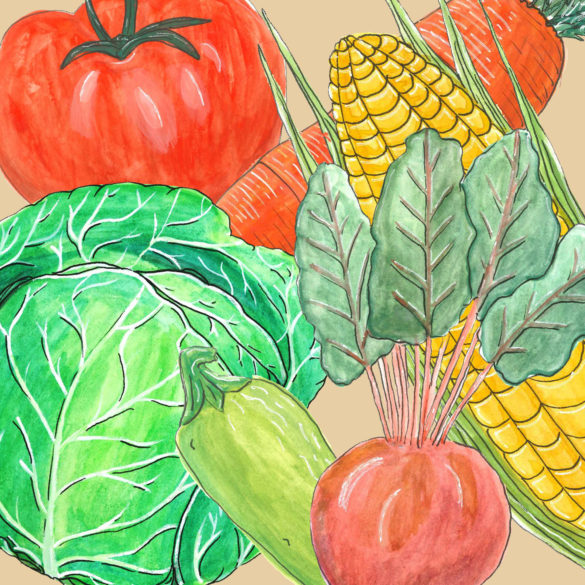Are you hungry? Is your head feeling off to one side and foggy? Is your body aching each time your stomach calls for attention? You’re thinking about the last thing you ate as you read this, aren’t you?
According to Cure Hunger, one in seven Americans struggles to get enough to eat. This isn’t just about money, it’s about availability. While poverty and hunger go hand-in-hand, a large issue that gets brushed aside is food insecurities. Having limited or uncertain availability of food that is nutritional and safe is a huge obstacle for the 37.2 million people living in food-insecure households, also from Cure Hunger.
In Delaware County, over 18,000 people have food insecurities, as reported in Feeding America. Surrounding counties have seen spikes in the increase of food insecurities from the pandemic. Grant and Madison County had similar food ratings prior, but are now joined by Blackford, Jay, Randolph, Wayne, and Henry County.
What does all of this mean? It means that Muncie is officially classified as a food desert. According to the USDA, a food desert is an area that has poor access to food outlets, meaning it’s a low-income and low-access community. Think about how far a supermarket is from your home–could you walk there?
Issues like this aren’t solved overnight. It’s been a struggle for all research on food deserts. In 2018, graduate student Andrew Imboden and associate professor of environmental, geology, and natural resources Joshua Gruver wrote a research paper on Muncie’s food insecurities and mapped its food desert. Their research pointed them in the direction of increasing market access to local producers in order to provide nutritious food to the communities. Just as they got a chance to practice these solutions–a pandemic hit.
“The pandemic has really opened up people’s eyes to the issues that we have here,” Gruver says. “This town and surrounding areas have especially [been at risk] after a lot of the manufacturing jobs left. With COVID, people being laid off, people being out of work, the need for emergency food has increased dramatically.”
Gruver came to Ball State to work with farmers, not to study food systems. It was through them that he realized all the issues surrounding food insecurities. Taking his research to the community, several organizations have stepped up to help. Second Harvest Food Bank, Muncie Food Hub, Feeding Indiana’s Hungry, the Ross Community Center and church groups are just some of the organizations working with farmers to bring food to the people of Muncie. However, their work has created unique issues, such as hours of waiting for food because of the demand.
“[Food deserts] are evolving into a constant part of our conversation here in Muncie,” Gruver says. “Before you had Purdue Extension, you had the university and people who were interested in food, emergency food, nutrition, and those kinds of things. Over the past five years, we’ve done a lot of work in connecting those pods. Now, we all meet once a month to check in, how are we doing, what are the things that we need to be doing [and] sharing resources. We’re able to leverage each other’s services and come together a lot more than ever.”
CEO of Second Harvest Foodbank of East Central Indiana Bekah Clawson discussed just that. Through the organization, they go beyond food distribution and help with utilities and rent. All of their hard work is through volunteers, which was limited by the pandemic and replaced with the National Guard social soldiers. But, currently, supply chain issues and high gas prices have brought a new problem to deliveries.
“We took a field trip recently, [and] there are several food banks in Indiana who run their own markets,” Bekah says. “Folks can come in and actually shop and you get points. So for instance, if you were to get 30 points, then each of those items in that particular store would have points assigned to them. Sometimes it has to do with how much you have available and how much you can give each person. Produce is usually free because that’s one of those things that you want people to get. It gives people dignity, they have the option to come in and get a card, it looks like they’re gone to a grocery store, they just don’t use money, they use points.”
While the idea of community gardens and delivery for farmers sounds good on paper, the reality is blunt. Talks of hydroponic systems to help lengthen the period for farmers to grow more food have been struggling for years. Bekah says it’s part of multiple solutions, but the reality is to focus on specific neighborhoods.
“What is very confusing about food labeling is the sell-by date and the expiration date,” Bekah says. “You see [produce] and it might have a little brown spot on it, does that mean it’s not good? I mean a lot of food banks put together these sort of food coding guidelines, which say how long something is good. For instance, food in a can, even if it’s high in acid, like spaghetti sauce or soup, can still be consumed 12 to 18 months after the date on the can, but a lot of people just don’t know that and they figure, ‘oh gosh, this is expired— something to throw out.’ We’re just a middle person, but I just don’t want to see good food that could be consumed in the landfill.”
Still, the issue is delivering fresh food to Muncie. Most of the food that is provided by these groups, no matter the funding, is shelf-stable food. This means they are preserved, processed, vacuumed, sealed, or frozen— which requires chemicals. Fresh food like cabbage is easier to distribute, but it doesn’t make a healthy balance. The problem is bringing the farmers to the people, and the solution isn’t just a farmer’s market.
“We learned that there are a lot of people here who are passionate about growing food, but they didn’t have places to sell it. At that time, there was just the Minnetrista farmers market. Farmer’s markets actually can be a struggle, they’re quite demanding,” Gruver says.
The idea of connecting fresh-grown food to the people brought the Muncie Food Hub to fruition.
Getting funding and grants to pay farmers the true cost of their produce, while providing it for a low cost to the community, would require mobilizing farmer’s markets, which takes us back to Andrew’s original research paper. The maps show that the big issue with food deserts is mobility. It’s hard to get transportation to the supermarkets. Mobilizing food helps reach the areas that need the resources the most, efficiently and effectively.
Once the community has food, they’d need to know how to actually consume it. Education has been an underlying theme in all of the issues from the beginning, but being able to cook was lost in the numbers. Delivery would have to come with instructions or website tutorials that can be accessible to everyone. It’s easy on paper to argue the solutions, but it’s up to volunteers and the community to come together and make this possible.
“We need all the help we can get, all the talent that we can get to help us look at these issues from multiple perspectives,” Gruver says. “This area’s an amazing place in that there are a lot of people who care. That’s been humbling for me, coming in here [from the East Coast].”
There is no one solution. And as the pandemic has taught us, we need to act now. Executive director of Feeding Indiana’s Hungry, Emily Weikert Bryant, has just the information for you.
“I wish people knew that there is a network of food banks and pantries out there to provide them help when they need it,” Emily says. “There isn’t really any single solution to food deserts. Every community’s needs and situations are going to be different. My job, and our organization, focuses on advocacy and public education, as well as running programs and bringing together coalitions to assist our eleven member food banks and the clients they serve.”
If you are struggling with food insecurities, you are not alone. To find a food pantry near you, call 211.
Sources: Cure Hunger, Cure Hunger, Feeding America, Feeding America, Feeding America Action, USDA
Images: Kami Geron and Janie Arseneaux
Featured Image: Kami Geron




